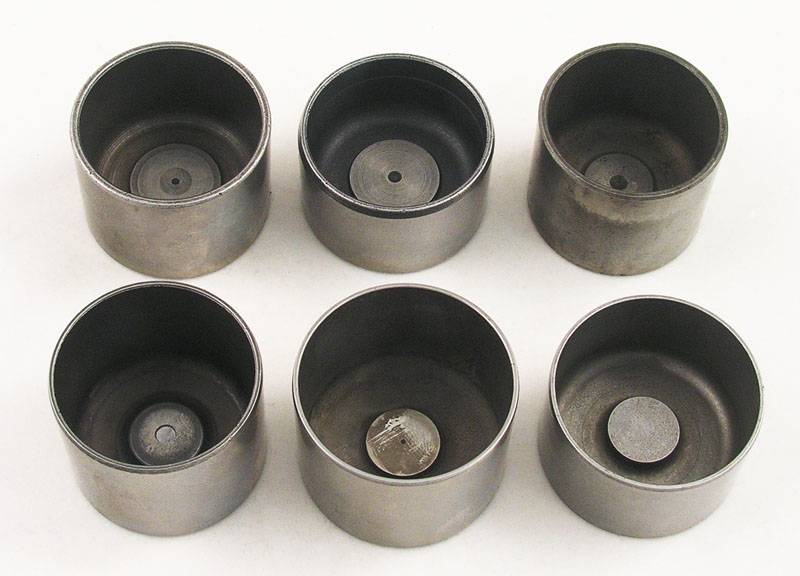
The Up and Down of Tappets
by Dick Maury
The tappets I am referring are the bucket like devices that the camshaft pushes on to open the valves. The usually sit on top of a shim that is selectable for clearance adjustment. Jaguar started using tappets in the first dual overhead camshaft engines in the late 40's. The design has been virtually unchanged but there have been slight changes. In this article, I will explain the variances and interchangeability.

The top left tappet is the original style that was used in the XK120's all the way through the XJS V12 models. The diameter of this style tappet is 1.371". It is 1.004" tall and weighs 65 grams. It is the heaviest of the tappets. The measurement from the face of the tappet to the shim contact pad is .223". This is important if you are going to use the later tappets as they are not all equal.
The middle top is the replacement from the factory. Just a little lighter at 55 grams due to the shorter height of .828". Other than that, all other dimensions are equal and it is a direct replacement for all earlier engines.
On the top right is a early XJ40 tappet. These are rather rare as it was still made of the heavier steel and weighs in at 60 grams. The surprising thing is that it is smaller in diameter at 1.309" and still weighs almost as much as the earlier tappet. The surface to surface dimension is also smaller at .164". Not really a problem on interchangeability as it is to small in diameter to fit any other Jaguar head. The problem encountered with this was that the XJ40 heads only used a single valve spring. With the heavy weight, valve float would be encountered at a lower speed and spring fatigue would occur with resulting breaking springs. Jaguar quickly came out with a light weight tappet of the same dimensions and only weighing 45 grams, a 25% reduction with the same functionality. The tappet on the lower left is the lighter version as mentioned.
With the introduction of the 4 litre to replace the 3.6, Jaguar increased the outside diameter of the tappets back to the earlier dimension of 1.371". This is the tappet on the lower middle. Face to face was the same as the earlier XJ40 tappets at .164" so not interchangeable with the earlier XK tappets. Weight however did come down even further to 40 grams. This tappet was continued up through the X300 production. It is dimensionally the same as the XK tappet except for the face to face dimension. Ray Livingston brought up that these could be used when the seats are cut to far as it would gain .059" in additional clearance.
There is an oddball tappet in the group. It is on the lower right. The face to face dimension is .223" and the outside diameter is the same as the XK tappets at 1.371" so it is totally interchangeable. It is .831" tall. The best news is that it only weighs 30 grams. This is less than half the weight of the early XK tappet. With all of this weight having to move up and down up to 3000 times a minute (assuming 6000 RPM max), the less weight, the better. The only problem is that these are only off of certain late XJ40 heads. Seems some of the camshafts have a higher base (closer to the center line of the cam) and require the extended face to face dimension. There is no specific Jaguar part number to order them. Another advantage of this particular tappet is that the inside shim contact surface is rather pronounced. If it is necessary to use a very thin shim, this one would reach into the retainer better.
Nothing against the V8 cars but the tappets changed again on them and I have not included them here nor the ones for the V6 engines.